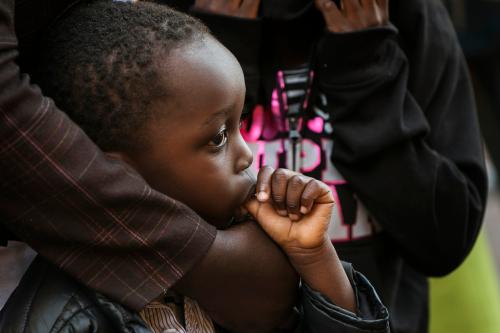The following is a summary of a private roundtable discussion, and thus opinions are provided without attribution.
On May 24, the Brookings Center on Children and Families hosted a private roundtable with policymakers, researchers, and think tank experts to discuss the state of research on early childhood education, its short- and long-term impacts on student outcomes, and relevant policy questions including cost, teacher training, and more. The roundtable was framed by findings in a new report by Isabel Sawhill and Morgan Welch which reviewed the literature on early childhood education and provided insight into long-term impacts using data from the Social Genome Model.
Read a short summary of key points from the discussion below and read the full report here.
We need to update research on what works and what doesn’t work.
Discussion from the first panel of the roundtable highlighted that much of the research on early childhood education is in need of an update, a point that the Sawhill and Welch report made in two particular ways. First, much of the seminal research on the impact of early childhood education has been on small, well-funded programs, not national programs for the general public. Second, the data in many important pre-school studies is dated, having been done in a time with a very different set of social and economic circumstances, for example lower levels of educational attainment among mothers. In short, panelists agreed many of these early studies provide little guidance about what policies and practices would be most effective today.
Furthermore, panelists and the Sawhill/Welch report also noted that studies of more recent programs show more mixed results, and it isn’t clear why. For example, one panelist pointed out that “fade out” and “bounceback” effects are largely unexplained: Studies show large effects on outcomes as measured by tests at kindergarten entry, but then by 3rd grade there is little or no difference between those who attended a pre-school program and those who didn’t (“fade out”). Meanwhile other studies show benefits such as higher high school graduation and college attendance, for pre-K attendees (“bounceback”). This conflicting information about short- and long-term impacts presents significant challenges for policy decisions that need to be made urgently, the panelists agreed.
Investing in early childhood education is expensive for parents and the government
A key consideration for both parents and policymakers that came out of the panel discussion was related to the cost of early care. As Sawhill and Welch noted, studies that showed success of pre-K programs were often small, intensive, and very well-funded. In the opening panel of the roundtable, it was noted that many families are highly price sensitive and often cannot afford the highest quality care for their children. Panelists discussed the merits of two approaches for child care cost subsidies: which could be universal (available to all students, regardless of income level) or targeted (only available based on demographic or financial criteria). While studies have shown universal programs to be more effective overall, targeted programs are more cost effective for the government to provide. In either case, as one presenter noted, “Access to Pre-K without quality is not real access”—that is, whether targeted or universal, pre-K programs must use high quality curricula and employ effective teachers in order for children to benefit.
Importantly, on the point of costs, one participant noted that recent calls by pre-K teachers for pay and educational equity with K-12 teachers would likely help drive improvements in quality and teacher retainment, but this would require large investments to both attract more people into the profession and to provide training for current teachers. And investing in pre-K alone isn’t enough: Panelists noted that, to achieve the maximum benefits from pre-K, the U.S. also needs to make sustained investments after the early childhood period (i.e., in K-12 education as well) because early investments have more payoff if they are supplemented with later investments (“dynamic complementarity”). Such investments could have a significant return explained one panelist, and in time they could pay for themselves in the form of increased lifetime earnings for students and thus higher tax revenue for governments.
The Brookings Institution is financed through the support of a diverse array of foundations, corporations, governments, individuals, as well as an endowment. A list of donors can be found in our annual reports published online here. The findings, interpretations, and conclusions in this report are solely those of its author(s) and are not influenced by any donation.






Commentary
What works in childhood education and how are we going to pay for it?
June 15, 2023